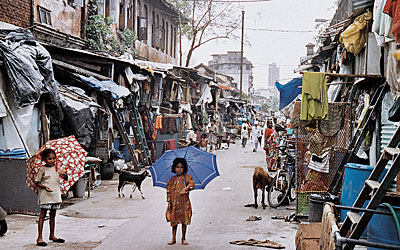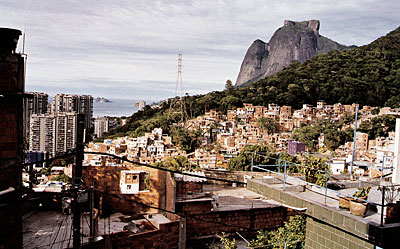This 2006 article, City Planet, is about urbanization, squatting and slums.

"Pavement dwellers" living in open-air homes in Byculla, a Mumbai neighborhood
City infrastructure and housing in the developing world cannot keep up with the rapid pace of urbanization. The result: vast informal settlements and neighbourhoods. The article tells of the bad and the good, the crowded, dirty, and yet incredibly vibrant communities:
Let no one romanticize the conditions of slums. New squatter cities usually look like human cesspools and often smell like them. There is usually no infrastructure at all for sanitation, for water, for electricity, or for transportation. Everyone lives in dilapidated shacks jammed together wall to wall, with every room full of people. A typical squatter city, which may stretch for miles, has grown without a plan or government, in an area generally deemed uninhabitable: a swamp, a floodplain, a steep hillside, a municipal dump; clustered in the path of a highway project, squashed up against a railroad line.
But the squatter cities are vibrant. Each narrow street is one long bustling market of food stalls, bars, cafes, hair salons, churches, schools, health clubs, and mini-shops of tools, trinkets, clothes, electronic gadgets, and pirated videos and music. What you see up close is not a despondent populace crushed by poverty but a lot of people busy getting out of poverty as fast as they can.
What about the economic impact?
Gradually a consensus is emerging about the economic value of rural-to-urban migration. This migration, "on the whole, acts to alleviate poverty in both the urban and rural sectors," wrote geography professor Ronald Skeldon in 1997. He explained that the urban "informal sector, with its capacity to create an almost infinite variety and number of activities" and its "considerable potential for self-organization... can create a dynamic economy and society."
[...]
Cities have been the wealth engine for civilization since its beginning. Thus the bottom line in the U.N. report: "Cities are so much more successful in promoting new forms of income generation, and it is so much cheaper to provide services in urban areas, that some experts have actually suggested that the only realistic poverty reduction strategy is to get as many people as possible to move to the city."
Of course, cities, slums and informal developments aren't uniformly good.
It's easy to gloss over the enormous variety among the thousands of emerging cities with different cultures, nations, metropolitan areas, and neighborhoods. From that variety is emerging an understanding of best and worst governmental practices - best, for example, in Turkey, which offers a standard method for new squatter cities to form; worst, for example, in Kenya, which actively prevents squatters from improving their homes. Every country provides a different example.

View from a balcony in Rocinha, Brazil, a dense and relatively prosperous squatter community of 150,000 people, built on steep hills above Rio de Janeiro
These different governmental approaches are detailed for four major squatter cities in Robert Neuwirth's Shadow Cities: A Billion Squatters, A New Urban World, heavily referenced in this article. Aside from security (i.e. NOT living in fear of the government bulldozing your community), what helps these communities thrive?
Social cohesiveness is the crucial factor differentiating "slums of hope" from "slums of despair." This is where CBOs (community-based organizations) and the NGOs (nongovernmental organizations) that support local empowerment play such an important part. Typical CBOs include, according to the 2003 U.N. report, "community theater and leisure groups; sports groups; residents associations or societies; savings and credit groups; child care groups; minority support groups; clubs; advocacy groups; and more... CBOs as interest associations have filled an institutional vacuum, providing basic services such as communal kitchens, milk for children, income-earning schemes and cooperatives."
Women play a crucial role, as it is they who form and participate in many of the communal self-help organizations. Urbanization also brings decreasing birthrates and increased opportunities for women.
Already, as a result of the headlong urbanization, birthrates have plummeted in the developing world from 6 children per woman in the 1970s to 2.9 now. Twenty "less developed" countries, including China, Chile, Thailand, and Iran, have already dropped below the replacement rate of 2.1 children per woman.
And what about the young and fertile couples in developing countries? If current demographic trends continue, 2 billion of them will live in the cities, choosing to have fewer children. It's not because they're poor. They were poor in the countryside. In town they see opportunity to come up in the world. Having fewer children, who are better educated, is part of that equation.
[...]
"In the village, all there is for a woman is to obey her husband and family elders, pound grain, and sing. If she moves to town, she can get a job, start a business, and get education for her children." I heard this remark, made by a global community activist, in 2000 at a Fortune magazine conference in Aspen, Colo. It was enough to explode my Gandhi-esque romantic notions about the superiority of village life.
Cities are important. A dense city, like New York, is the most environmentally reponsible way to organize large numbers of people. Depending on their organization, cities have shown other benefits too. They represent our future, and our past.
Cities are remarkable organisms. They are the most long-lived of all human organizations. The oldest surviving corporations (Stora Enso in Sweden and the Sumitomo Group in Japan) are about 700 and 400 years old, respectively. The oldest universities (in Bologna and Paris) have lasted a thousand years. The oldest living religions (Hinduism and Judaism) date back about 3,500 years. But the town of Jericho has been continuously occupied for 10,500 years. Its neighbor Jerusalem has been an important city for 5,000 years, though it was conquered or destroyed 36 times and it suffered 11 conversions from one religion to another. Many cities die or decline to irrelevance, but some thrive for millennia.
If you're interested, read the full article here.
1 comment:
Another important aspect of the squatter communities is overpopulation. Population control is one of the reasons for the greater prosperity in the "global north."
Poor countries would find it difficult enough to deal with the needs of stable populations.
Post a Comment